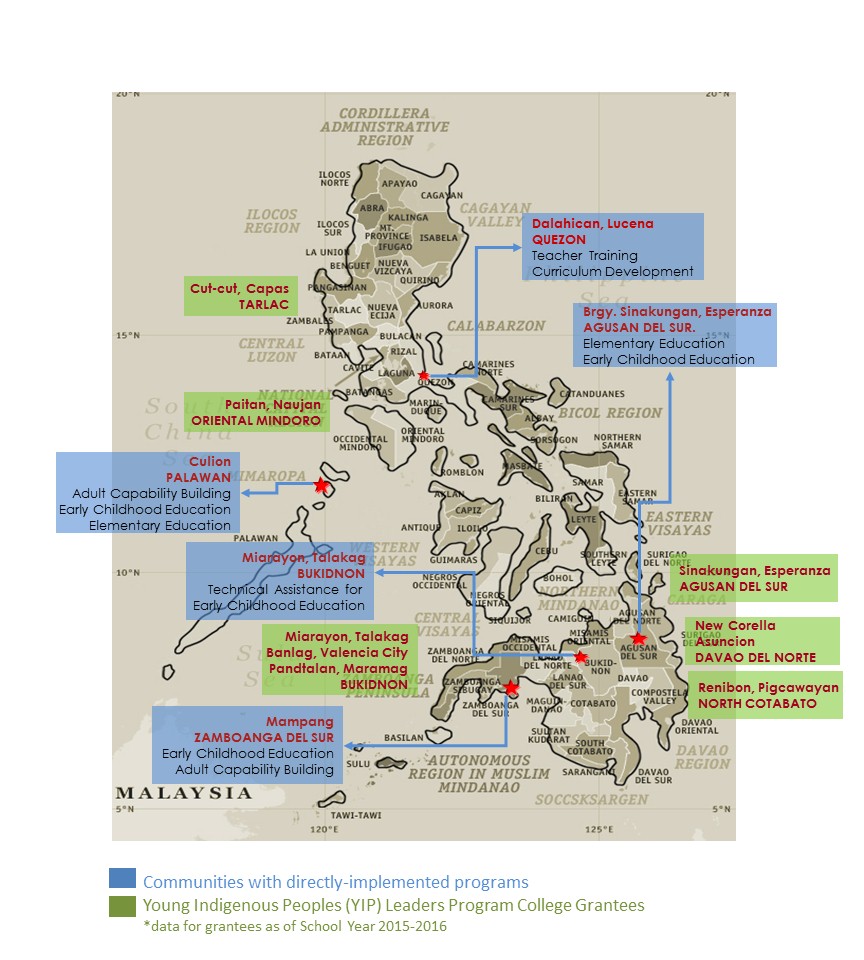PARTNER COMMUNITIES
Tagbanua of Culion, Palawan
The Tagbanua Indigenous People, one of the oldest ethnic groups in the Philippines, can mainly be found in the Province of Palawan. In Northern Palawan, the Municipality of Culion is one of the towns in which Tagbanua settlements can be found.
Culion belongs to the Calamianes group of islands, and has a total land area of around 415 square kilometers. The Tagbanua are the original inhabitants of the islands, having lived there even before it was turned into a leper colony during the American occupation in the early part of the 20th century. The whole of Culion was under the Department of Health (DOH) until 1995 – 1996, when it was declared leprosy-free and became a municipality. The Tagbanua are now marginalized and are a minority group among the islands’ 18,000 people, which include the Calamianen and Cuyonon from other parts of Palawan. As before, they still make a living mainly through fishing and food gathering. They reside in remote parts of Culion, most of which can be reached only by boat. With seawaters separating them from the town proper, they barely have access to the basic necessities of potable water, electricity, and other government services, much less education.
Bajau of Lucena, Quezon
The Bajau, sometimes referred to as “sea gypsies”, pertain to a Moro indigenous ethnic group largely found in Maritime Southeast Asia. In the Philippines, the Bajau are traditionally from the many islands of the southwestern region, including the coastal areas of Basilan, Jolo and Sultan Kudarat. They are known to be nomadic in nature, often choosing to reside in one place only for a brief period of time.
In the 1990’s, many Bajau families started to migrate to different parts of the country where ports are located in order to escape the violence inflicted upon them in their places of origin. One of the communities that some of them chose to settle in is Lucena City, which is home to one of Luzon’s biggest fish ports.The Bajau presently residing in Lucena continue to speak their own language and maintain their indigenous life ways, but illiteracy also remains high among them. Some of them are fishermen, while many make a living by begging for alms. In the months leading up to the holiday season in the Philippines (September to December), Bajau families – including women and children – often travel to Manila or other big cities in order to beg in the streets, making them exposed to increased risks and vulnerabilities.
Higaonon of Sinakungan, Agusan del Sur
The indigenous Higaonon of Sinakungan, Esperanza, Agusan Del Sur is one of the many ethnic groups in Mindanao. Sinakungan is known as the heart of the Higaonon because it is where their Holy Mountain is located, believed to have been the dwelling place of the “Ininay” and “Inamay,” or mother and father of their entire lineage.
The Higaonon still practice their rituals as a way living out their cultural beliefs and traditions. It is in their area that the traditional life ways of the Higaonon from around the country are still being purely practiced. Sinakungan is one of the farthest barangays in the province that has very little access to basic social services because of its geographic location.
Bajau of Mampang, Zamboanga
In September 2013, a faction of the Moro National Liberation Front encroached in Mariki, Rio Hondo and other four other coastal villages in Zamboanga City, engaging in prolonged firefight with government troops. Now known as the “Zamboanga Siege,” the armed conflict has resulted in fatalities and injuries among combatants and civilians, and have displaced around 35,000 people.
Of the total displaced families, over 600 were from the Bajau tribe with children & youth that are typically not able to go to school due to financial constraints. Their situation was further aggravated by the Siege, which forced them to live in congested evacuation camps and made them more vulnerable to diseases. Many of them also frequently loiter and beg on the streets to help their families make a living, rendering them prone to accidents.
Mampang is a coastal area with a distance of 1.5 kilometers from the highway and approximately 7 kilometers from Zamboanga City Proper. It is one of the temporary shelters built by the City Government of Zamboanga for Internally Displaced Persons, particularly the Bajau. There are about 300 bunkhouses built in this transitory site, 228 of which are occupied by the Bajau. The site has communal kitchen centers, functional water points, wells/hand pumps, and permanent/temporary latrines.
Talaandig of Miarayon, Bukidnon
There are approximately 5,000 indigenous families of Talaandig origin in Miarayon who are part of the Higaonon ethnolinguistic group. Farming is their main source of livelihood.
Miarayon is located in the southeastern section of Malaybalay City, and belongs to the Municipality of Talakag in the province of Bukidnon. The area is composed of six barangays — Baylanan, Lapok, Miarayon, Lirongan, San Miguel and Tagbak. Miarayon covers approximately 22,619 hectares with a total population of around 7,000. The inhabitants of Miarayon are diverse peoples — 80% Talaandig, 15% Dumagat, 4% Maranaw/Muslims, and 1% Igorot.

